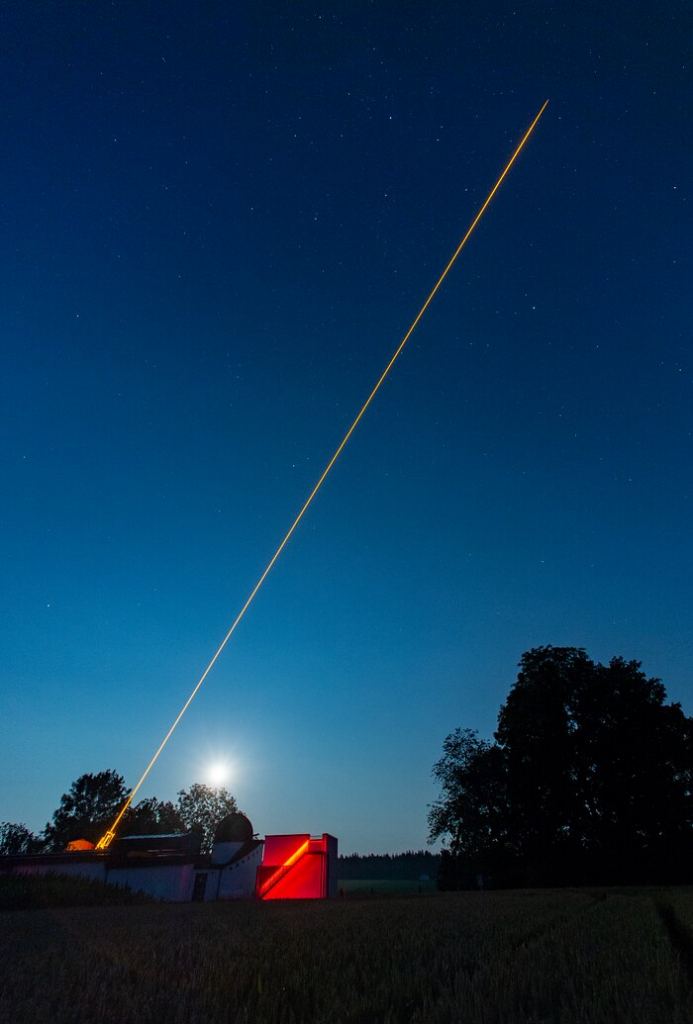In some applications, bigger lasers mean better lasers. That is the case in astronomy, where lasers are used for everything from telescope calibration to satellite communication. The European Southern Observatory (ESO) and some of its commercial partners have developed a laser 3 times more powerful than the existing industry standard. With that increased power level, the new system has the potential to dramatically improve the way telescopes deal with one of the most fundamental problems in ground-based astronomy – atmospheric turbulence.
Regular atmospheric turbulence is commonplace on Earth and is the cause of what the human eye perceives as the stars “twinkling.” However, to a telescope, turbulence that is unaccounted for could lead to entire data sets being thrown out. Telescopes have a standard technique to eliminate any such effects – they calibrate using a known stable star.
UT video explaining atmospheric turbulence.The obvious problem is sometimes there are no stars they can use to calibrate to. So scientists came up with a way of making an “artificial star” that would allow observatories to calibrate against a stable observable object no matter which direction they were facing. That technique involves blasting sodium atoms 90 km up in the atmosphere with a laser.
Today that technology exists as the Four Laser Guide Star Facility, which operates the ESO’s Very Large Telescope (VLT). Coming in at a respectable 22W of power, this calibration tool has been essential to the VLT’s successful operation. However, the more powerful the laser brought to bear on the sodium atoms, the more stable the calibration “star.” So ESO has bumped the power level up to 63W – almost a 3 fold increase over the existing system.
 This wide-field image shows the CaNaPy laser being tested on-sky at the Allgäuer VolksSternwarte Ottobeuren observatory in Germany. The laser, based on ESO-patented technology, excites sodium atoms in the upper atmosphere, creating an artificial source that can be used to monitor and correct atmospheric turbulence. This laser will be eventually installed at the European Space Agency’s (ESA) Optical Ground Station in Tenerife, Spain, as part of a collaboration between ESO and ESA to use adaptive optics for astronomical and satellite communication purposes.
This wide-field image shows the CaNaPy laser being tested on-sky at the Allgäuer VolksSternwarte Ottobeuren observatory in Germany. The laser, based on ESO-patented technology, excites sodium atoms in the upper atmosphere, creating an artificial source that can be used to monitor and correct atmospheric turbulence. This laser will be eventually installed at the European Space Agency’s (ESA) Optical Ground Station in Tenerife, Spain, as part of a collaboration between ESO and ESA to use adaptive optics for astronomical and satellite communication purposes.
Credit – ESO
That increase is thanks to work on developing an advanced Raman fiber amplifier laser source, created by MPB Communications – a Canadian company that serves as one of ESO’s commercial partners. They weren’t alone in developing technologies to help improve the calibration lasers. TOPTICA Photonics Ag is a German company specializing in making frequency “chirping” systems that allows the laser to bounce back and forth between several frequencies. Larger bandwidths mean more excited sodium atoms and a bright star to use for calibration.
Calibration isn’t the only thing the improved lasers are useful for, though. Satellite communication systems have become much more important lately, with SpaceX’s Starlink leading to a new era of space-based communications. However, they are limited in their use of one of the most high-speed data transfer techniques. Optical communication between satellites and Earth itself is complicated by the same atmospheric turbulence phenomena that can throw off telescopes. With this higher power laser able to create more stable calibration points for these systems, optical communication becomes a much more appealing data transfer method.
 This image shows the 57W CaNaPy laser during a field test on the 0.6m telescope at the Allgäuer VolksSternwarte Ottobeuren observatory in Germany. The laser light goes from the interior of the telescope to its secondary mirror and bounces back to the primary mirror, where it is finally reflected towards the sky. The laser, based on ESO patented technology, will eventually form part of the CaNaPy Laser Guide Star Adaptive Optics system to operate at the European Space Agency’s Optical Ground Station in Tenerife, Spain. It will help correct astronomical observations for the blurring effect caused by turbulence in the Earth’s atmosphere.
This image shows the 57W CaNaPy laser during a field test on the 0.6m telescope at the Allgäuer VolksSternwarte Ottobeuren observatory in Germany. The laser light goes from the interior of the telescope to its secondary mirror and bounces back to the primary mirror, where it is finally reflected towards the sky. The laser, based on ESO patented technology, will eventually form part of the CaNaPy Laser Guide Star Adaptive Optics system to operate at the European Space Agency’s Optical Ground Station in Tenerife, Spain. It will help correct astronomical observations for the blurring effect caused by turbulence in the Earth’s atmosphere.Credit – ESO
Scientists plan to install the new laser system, part of the CaNaPy Laser Guide Star Adaptive Optics system, at an ESA observatory in Tenerife, Spain. If the system proves its value, it can serve as a basis for other improved calibration and communication tools throughout the expanding observational and networking platforms spread throughout the world.
Learn More:
ESO – New powerful laser based on ESO technology passes field test
SPIE – CaNaPy: SatComm LGS-AO experimental platform with laser uplink pre-compensation
Novus Light – Powerful New Laser Passes Field Test
UT – Artificial Star Shines in the Southern Sky
Lead Image:
CaNaPy laser undergoing a test in Germany.
Credit – ESO

